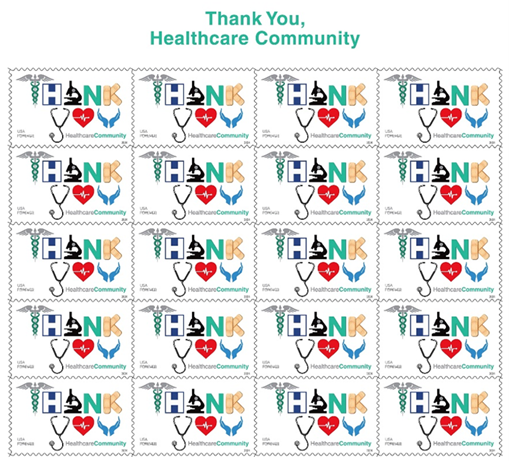
WASHINGTON — In collaboration with the U.S. Department of Health and Human Services, the U.S. Postal Service today honored the medical community with a new commemorative Forever stamp. Thank You Healthcare Community Stamps are now on sale at post offices nationwide and online at usps.com/shopstamps.
A special dedication ceremony was held at the U.S. Department of Health and Human Services' Hubert H. Humphrey Building in Washington, DC.
“The Thank You Healthcare Community stamp is special and recognizes the hard work of all healthcare workers across the country. We are with you and our memories are still fresh,” said U.S. Department of Health and Human Services Secretary Xavier Becerra. “It is a great honor to have stamps commemorating the achievements of people in the medical field. It is a well-deserved honor.”
“We understand the importance of recognizing those in the helping professions because that is how we think about the Postal Service, as well as those in the medical community. Our employees are also committed to serving others,” said Postmaster General Louis DeJoy. “They know the habits of their customers and the rhythms of their communities. They are often the first to alert emergency personnel when something goes wrong, and they are literally on every street in every neighborhood, so first responders can We can often provide initial comfort and care before you arrive.”
Mr. DeJoy was joined by Dr. Loretta Christensen, chief medical officer of the Indian Health Service, and Dr. Andrea Anderson, associate professor and associate chief of family medicine at the George Washington School of Medicine and Health Sciences.
News about the stamp is being shared on social media using the hashtag #ThankYouHealthcareStamp.
background
With nearly 16 million employees, healthcare is one of the largest and fastest growing industries in the United States. This includes doctors, surgeons, dentists, nurses, midwives, pharmacists, laboratory technicians, health care workers, home health aides, hospital administrators, emergency medical workers, and more. It also includes public health professionals such as epidemiologists, microbiologists, and data analysts. These essential workers spend their days and nights in hospitals, clinics, private offices, laboratories, nursing homes and rehabilitation centers, and patients' homes. The biggest health care workers so far are nurses. Almost 23% of all healthcare workers are registered nurses.
Healthcare workers are our family, friends, and neighbors. Overall, about 80% are women, and the percentage is even higher for nurses and many other professions in the field. Until the 1970s, very few women became doctors, but the number began to increase after that, reaching about 12 percent by 1980. Currently, approximately 39 percent of physicians and surgeons are women.
Dealing with sick, injured, and dying patients and distraught families every day can be extremely difficult, but healthcare workers also find it extremely rewarding. Research shows that scientists, doctors, and nurses are some of the most respected professionals because of their dedication to helping others.
Similarly, job satisfaction is high for many members of the medical community because they are able to make a difference in the lives of others, connect with people, and sometimes find solutions to complex problems. Work is not boring, it is fascinating. Practitioners often have the opportunity to move within their field, including to different specialties and settings. Importantly, as our country's population continues to age, the need for healthcare workers remains high.
stamp design
The stamp artwork consists of health-related icons with the word “thank you” spelled out over a pure white background. At the bottom right corner of the stamp are the words “Healthcare” in gray and “Community” in surgical green.
Top row:
T is for medical caduceus, a symbol commonly used in the medical field, such as the U.S. Public Health Service seal. This caduceus consists of two dark green snakes coiled around a gray staff surmounted by a pair of gray wings. (Although the “Staff of Asclepius” with its single-coiled serpent is the original symbol of the medical field, in the United States the caduceus has been associated with medicine/health care for over a century.)
The H is a traffic sign used to indicate nearby hospitals; it is a white H inside a dark blue rectangle.
A is a black microscope seen from the side.
The N is for Surgery and the green capital N represents the largest medical profession: Nursing.
K consists of three tan bandages of the type used on skinned knees.
2nd line:
Y is a stethoscope with black tube and stainless steel or aluminum alloy ear tube.
O is a medical heart icon. A jagged white electrocardiogram is drawn on the red heart.
The U is a cupped hand, an icon commonly used to indicate support and protection, and is shown in blue.
At the bottom right corner of the stamp are the words “Healthcare” in gray and “Community” in surgical green. “USA” and “FOREVER” are superimposed in the lower left corner in gray.
Bryan Duefrene was the art director and stamp designer.
Thank You Healthcare Community Stamps are issued in units of 20. As a Forever stamp, its value will always be the same as the current price of an ounce of first-class mail.
A video about the stamps will be posted on the Postal Service's Facebook and X (formerly known as Twitter) pages (facebook.com/USPS and x.com/usps) after today's event.
postal products
Customers can purchase stamps and other philatelic products at the Postal Store at usps.com/shopstamps, by calling 844-737-7826, by mail through USA Philatelic, or at post offices nationwide. For officially licensed stamp products, shop the USPS Officially Licensed Collection on Amazon. Additional information about stamps, first-day ceremonies, and stamp-inspired products can be found at StampsForever.com.
###

